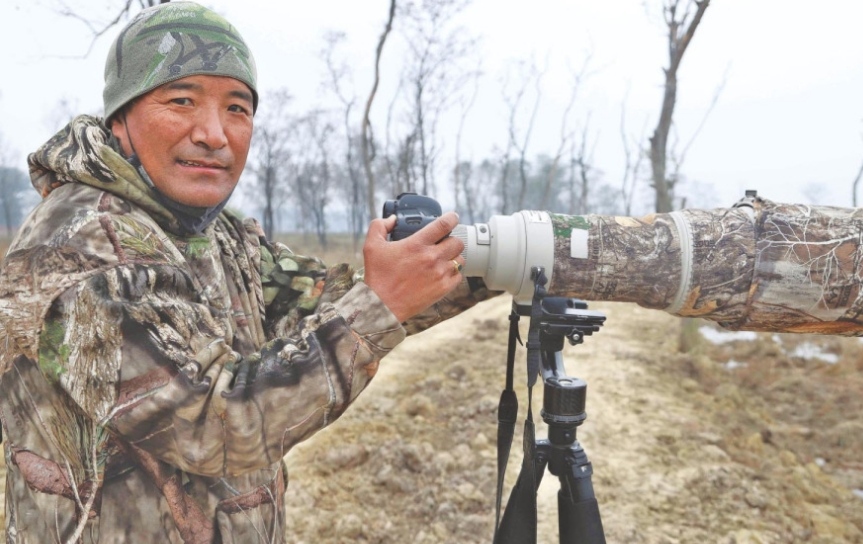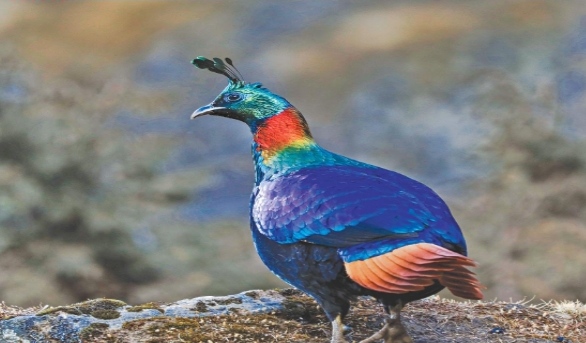Sherpa’s journey from mountaineering to wildlife photography
By Manoj Paudel
Pemba Sherpa, a mountaineer-turned-photographer, has captured over 425 species of birds in diverse terrains.

Sherpa of Solukhumbu says his life took a turn in 2012, after a tragic event on a mountain. Manoj Paudel/TKP
He climbed Mount Everest, the world’s highest peak, seven times between 1999 and 2006. He has scaled six eight-thousanders—Mount Manaslu (8,163m), Makalu (8,481m), and Dhaulagiri (8,167m) of Nepal; Shishapangma (8,027m) of Tibet; Gasherbrum II (8,035m) of Pakistan—and almost all the high mountain peaks of Europe. He also occasionally led mountain expeditions. He was established in mountaineering. But five years ago, he made an unlikely career switch and took up wildlife photography.
Meet Pemba Sherpa, who, at 56, is a rising star in Nepal’s wildlife photography firmament.
Sherpa, who hails from Solududhkunda Municipality in Solukhumbu, says his life took a turn on September 23, 2012. He was leading an expedition of 13 people, including seven foreign climbers, aiming to scale Mt Manaslu. After reaching Camp III, Sherpa climbed down to bring essential commodities, leaving the expedition members back at the camp. As he descended, he got a call on his satellite phone. Six French mountaineers and a Canadian had died when an avalanche hit their camp at Camp III. That was when Sherpa decided to leave behind his beloved mountains and focus on something that would help him look at life from a different perspective.
In the last five years, Sherpa has grown as a wildlife photographer. It was a difficult start. He was restless for many days after the tragic incident in Manaslu. His wife understood what he was going through and gifted him a Canon 80D on his birthday so he could focus on things other than the tragedy. Gradually, he started enjoying photography and even began indulging in mobile photography. He went to France in 2018 when the FIFA World Cup was underway in Russia. He placed a bet on France with his French friend and won the bet. His friend bought him a Tamron 150-600 G2, an ultra telephoto lens, which helped him explore his abilities as a photographer further.
The lens enabled Sherpa to take shots of birds and wild animals from afar. He then went on to buy a Canon 5D Mark IV, which he says helped him further hone his skill as a wildlife photographer. Since 2019, he has taken up wildlife photography full time. “I go from lowlands in Tarai to highlands in the mountains to take photos of wildlife,” he said. “I am happy when I am on the road.”
In the past five years, Sherpa has captured more than 425 species of birds. He has visited Chitwan 16 times to capture a tiger in his camera frame. He succeeded in encountering tigers only on his 16th visit. “I was dumbstruck to see five tigers at different places on a single day,” he said. “I was so excited that I didn’t even notice the lighting.”
His experience is not only exciting but also scary. “It was quite exciting to spend around 45 minutes watching a couple of tigers in the Madi area, Chitwan, in December 2022,” Sherpa recalled. “The female ran away upon seeing us. The male stayed in the water for a long time. I just enjoyed watching the tiger. Then I started taking photos. The tiger crossed the river and went to the forest after hearing my camera’s sound.”
He went to the same area the next day thinking that the tigers would come there again. “But there were no tigers, only Dhurbe, the notorious marauding elephant. We ran across the river to save our lives.”

Pemba Sherpa took snaps of Danphe in Renjo La pass. Photo: Courtesy of Pemba Sherpa
Sherpa has frequented various places from high Himalayas to the southern plain several times. He has patiently waited for days on end to capture birds in the Everest region. He captured Tibetan snowcock and Himalayan snowcock in Gokyo while he took snaps of Danphe in Renjo La pass. According to him, he got an Alpine accentor near Kalapatthar. He has also captured pheasants and chir pheasants.
This year in Mustang, Sherpa spotted European finch, European goldfinch, Mongolian finch, and horned lark, among 10 bird species, and captured them in his camera frames. Similarly, he captured more than 35 animal species including musk deer, goral, tahr, Himalayan blue sheep, blackbuck, water buffalo and swamp deer.
He has frequently visited Chitwan, Parsa, Bardiya, Shuklaphanta, Langtang and Sagarmatha national parks. He has followed birds across the country’s 30 districts. “I earlier thought that Asian paradise flycatcher was the best photo of mine. But I would now say the one of European finch that eats the seeds of a flower is the best I have ever taken,” he said. Sherpa said that watching birds and animals in their natural habitats provides a release from all earthly worries.
According to Manshant Ghimire, an ornithologist, Sherpa is one of the rare photographers who could capture European goldfinches. “Pemba rushed to Mustang after knowing that it was found there,” Sherpa said. “It is quite difficult to capture birds like goldfinches as it does not perch at a place for a long time.”
Until 2019, Sherpa could not count himself among the skilled wildlife photographers. He would post his photos on Facebook which gradually started receiving attention from his friends. One day, the wildlife photographer Chungba Sherpa called him to comment on his photos posted on his Facebook. Chungba told him that he had some fundamental shortcomings in taking photos and gave him basic tips and techniques on photographing birds and animals. He also taught him the technical aspects of using his equipment.
Sherpa accompanied Chungba to take wildlife photos. That is how his journey as a wildlife photographer began, he said.
Sherpa has set some records while taking photos of birds. He took photos of a small pratincole in the Manohara river. Later it was known that the bird species was spotted in the area after 25 years. Along with Sugam Tamrakar, he took photos of a long-billed plover that is rarely spotted in Nepal. The book Hundreds Birds to See Before You Die, written by popular bird writers David Chandler and Dominic Couzens, includes the photo of Himalayan cutia taken by Sherpa in the list.
Clearly, Sherpa has achieved a lot in his short career and made many memories with the wildlife. But for him, the most cherished moment was the time he encountered tigers in the wilds of Chitwan.
The first tiger was emerging from the river, he recalls. The second swiftly crossed the track. He could not take good photos of them. The big cats were in difficult places for the photographer to be able to capture them. Then came the moment he was waiting for. “Three tigers were walking together in my direction. I took 52 shots and only six turned out to be good,” he said. “It was one of the happiest days of my life.”
Source: The Kathmandu Post



